Field Test 2
Protene® Turf-Gyp+ Turf Field Test
Phoenix, Arizona
Download the Turf-Gyp+ Brochure
Applications: 7, 9 and 12lb/1000 sq ft of Turf-Gyp+ was applied to turf plots to determine its efficacy to support soil and turf nutrient profile improvements and soil remediation.
Results: Turf-Gyp+ was highly beneficial in improving foliar nutrient Ca uptake and soil nutrient profile and remediation properties.
Conclusion: This work is supportive of using Turf-Gyp+ to optimize turf and soil growing properties, especially when remediating soils high in Na, total salts and bicarbonate.
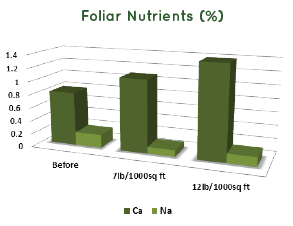
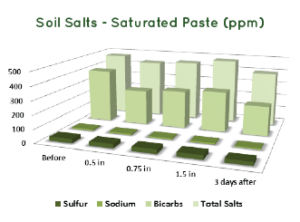
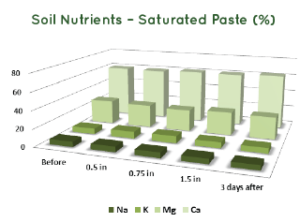
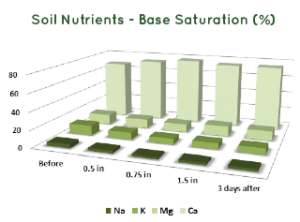
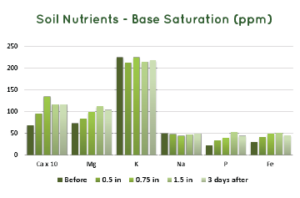
Turf-Gyp+ is the highest purity Gypsum available to the turf and landscape industries. Gypsum, is a sulfate mineral composed of Calcium Sulfate Dihydrate, with the chemical formula CaSO4•2H2O.
It is a chemically-reacted product, manufactured at a 100% dedicated, state-of-the-art synthetic Gypsum operation using the highest purity ingredients. It guarantees production of the highest purity and quality Calcium Sulfate Dihydrate available to the turf and landscape industries. It is a product that provides both key nutrients and improves soil physical and chemical properties – “A Turf and Soil Fertility Product”.
Benefits:
- Safe to use in all soil and turf applications
- High purity (96%)
- High level of Ca and S
- Highly available form of Ca and S
- Water-soluble
- 200X more soluble than limestone
- Solubilizes and moves into soils faster than calcium sulfate anhydrite and limestone
- Readily taken up by soil and turf
- Improves soil physical and chemical properties
- Reduces compaction, erosion, leaching and run-off
- A source of S that doesn’t burn turf
- Promotes retention and uptake of nutrients
- Improves turf growth and greenup
- Helps remediate degraded and high Na, Al, Mg,
- salts and bicarbonate soils
- Improves disease resistance
- Granulated to:
- Improve product uniformity
- Improve application properties
- Minimize dustiness and fines
- Improves nutrient delivery
Ca and S Requirement
Ca helps plants absorb nutrients better. Ca is a nutrient carrier in both the soil and turfgrass. In the soil, it helps control water movement and conductivity which means it can deliver more nutrients. In turf, Ca helps regulate water and nutrient uptake by the roots and movement through the turf. Ca aids cell division and cell wall formation and is critical for respiration during high heat and humidity periods. A Ca deficiency in turf could result in poor root development and limited response to N and iron applications.
S is present in certain amino acids, proteins, membranes, and coenzymes. In the absence of S, turf exhibits a chlorosis that frequently occurs as an intense yellow color. It may look similar to N and/or iron deficiencies. S enhances color, density and growth. S helps N to be used efficiently. Also, S reduces disease in turf.
Causes of S deficiency in turf:
High-performance varieties use more S
Reduced atmospheric S deposition
Declining S reserves in soil due to loss of organic matter, leaching of S in soils and turf removal of Ssolubilitygraph
Grass, like all green plants, captures energy from the sun and converts the energy into sugars and carbohydrates, which it eventually uses, along with plant nutrients and minerals for cell division or growth, development and reproduction. N helps give turf its green color and promotes both root and shoot growth. P is used for root development and K promotes disease resistance, winter hardiness, drought and foot tolerance. Ca and S supports green-up and healthy growth in turf.
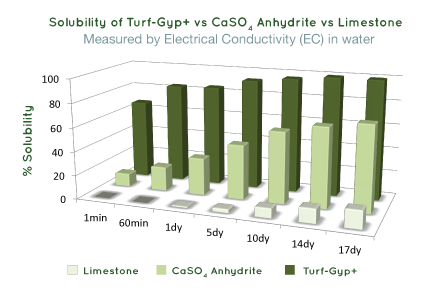
Using Cation Exchange Capacity (CEC) to Recommend Turf-Gyp+
Application Rates
In soil science, CEC is the maximum quantity of total cations, of any class, that a soil is capable of holding, at a given pH value, available for exchange with the soil solution. CEC is used as a measure of fertility and nutrient retention capacity. It is expressed as milliequivalent of hydrogen per 100 g of dry soil (meq+/100g). Clay and organic matter have electrostatic surface charges that attract the solution ions, and hold them.
This holding capacity varies for the different clay types and clay-blends present in soil, and is very dependent on the proportion of clay and organic matter that is present in a particular soil. In general, the higher the CEC number the higher the soil fertility.
The CEC can give insight into soil quality and site characteristics. Higher CEC likely indicates more clay, poor internal drainage, limited structure and soil compaction in high traffic areas. Low CEC is indicative of sandy textured soils prone to drought that invariably needs more organic matter to improve water holding capacity, but have open grainy structure that resist compaction.
The following table provides Turf-Gyp+ application rates that are recommended to maintain or improve the physical and chemical properties of soils.
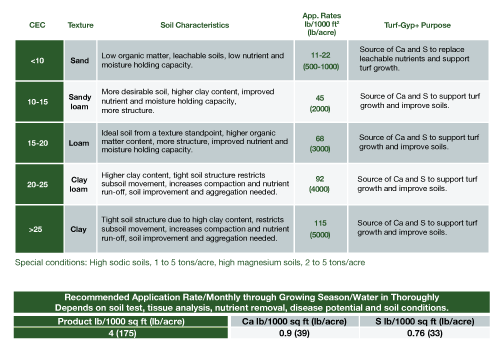
We Provide Performance Fertilizer
See how easy and cost-effective your turfgrass nutrition plan should be.

Contact
United Fertilizer Technologies, LLC
23011 Airpark Drive
Petersburg, VA 23803
Email: info@proteneusa.com
